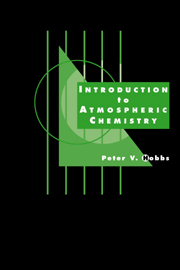Book contents
- Frontmatter
- Contents
- Preface
- 1 Evolution of the Earth's atmosphere
- 2 Half-life, residence time, and renewal time of chemicals in the atmosphere
- 3 Present chemical composition of the atmosphere
- 4 Interactions of solar and terrestrial radiation with atmospheric trace gases and aerosols
- 5 Sources, transformations, transport, and sinks of chemicals in the troposphere
- 6 Atmospheric aerosols
- 7 Cloud and precipitation chemistry
- 8 Tropospheric chemical cycles
- 9 Air pollution
- 10 Stratospheric chemistry
- Appendix I Exercises
- Appendix II Answers to exercises in Appendix I and hints and solutions to the more difficult exercises
- Appendix III Atomic weights
- Appendix IV The International System of Units (SI)
- Appendix V Some useful numerical values
- Appendix VI Suggestions for further reading
- Index
4 - Interactions of solar and terrestrial radiation with atmospheric trace gases and aerosols
Published online by Cambridge University Press: 05 June 2012
- Frontmatter
- Contents
- Preface
- 1 Evolution of the Earth's atmosphere
- 2 Half-life, residence time, and renewal time of chemicals in the atmosphere
- 3 Present chemical composition of the atmosphere
- 4 Interactions of solar and terrestrial radiation with atmospheric trace gases and aerosols
- 5 Sources, transformations, transport, and sinks of chemicals in the troposphere
- 6 Atmospheric aerosols
- 7 Cloud and precipitation chemistry
- 8 Tropospheric chemical cycles
- 9 Air pollution
- 10 Stratospheric chemistry
- Appendix I Exercises
- Appendix II Answers to exercises in Appendix I and hints and solutions to the more difficult exercises
- Appendix III Atomic weights
- Appendix IV The International System of Units (SI)
- Appendix V Some useful numerical values
- Appendix VI Suggestions for further reading
- Index
Summary
This chapter is concerned with the attenuation by atmospheric gases and aerosols of the incoming shortwave radiation from the Sun (solar radiantion), and the emission and absorption of outgoing longwave radiation (also called infrared, terrestrial, or thermal radiation) from the Earth and its atmosphere. These interactions play important roles in determining the energy balances, and therefore the temperatures, of the Earth's surface and the atmosphere. Also, the absorption of solar radiation by some atmospheric constituents can lead to photochemical reactions, which play crucial roles in atmospheric chemistry.
Figure 4.1 shows current best estimates of the annual global energy balance of the Earth-atmosphere system expressed in terms of 100 units of incoming solar radiation at the top of the Earth's atmosphere (I OA). About 22 of these units arc reflected back into space by clouds, aerosols, and gases, about 20 units are absorbed by the atmosphere, 9 units are reflected from the Earth's surface, and the remaining 49 units are absorbed at the Earth's surface. Measured in the same units, the Earth receives an additional 95 units due to longwave radiation from the atmosphere. Therefore, the total energy received by the Earth is 144 units. Thermal equilibrium at the surface of the Earth is achieved by these 144 units being transferred back to the atmosphere: 114 of them are radiated to the atmosphere as longwave radiation, 23 units as evapotranspiration (which is ultimately released to the atmosphere as latent heat in precipitation), and 7 units are transferred to the atmosphere by heat fluxes associated with turbulence, convection, and so on.
- Type
- Chapter
- Information
- Introduction to Atmospheric Chemistry , pp. 33 - 62Publisher: Cambridge University PressPrint publication year: 2000

